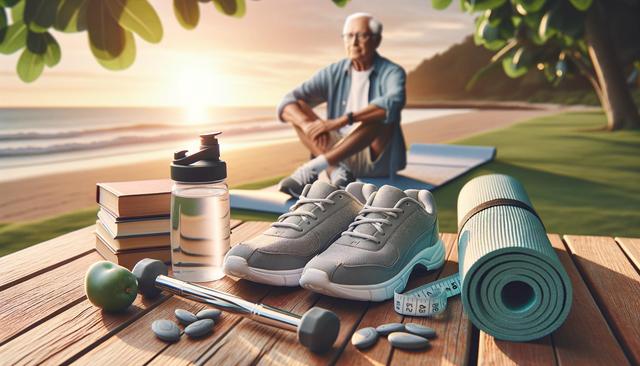Why Fitness Matters in Older Age
As we age, staying active becomes even more important for maintaining physical and mental well-being. Regular exercise can help older adults reduce the risk of chronic conditions, improve mobility, and support cognitive function. Senior fitness programs are designed with these goals in mind, offering low-impact, age-appropriate activities that cater to various fitness levels. These programs are not only about physical health but also contribute to better mood and social engagement.
Scientific studies have shown that consistent physical activity can help manage or prevent conditions such as arthritis, heart disease, and type 2 diabetes. Moreover, exercise boosts balance, reducing the likelihood of falls, which are a leading cause of injury among seniors. Participating in a fitness program can also enhance quality of life by fostering a sense of routine and purpose.
- Improved cardiovascular health
- Enhanced joint flexibility
- Better mental clarity
- Increased social interaction
Fitness programs tailored to seniors often include components such as stretching, strength training, aerobic movement, and balance exercises. These elements are carefully selected to minimize injury risk while maximizing health benefits.
Types of Senior Fitness Programs
Senior fitness programs come in a variety of formats, allowing individuals to choose what suits their needs and interests. Group classes are popular for their social aspect, while personalized one-on-one sessions can address specific health concerns or mobility challenges. Some programs are held in local community centers or gyms, while others are available online for those who prefer exercising at home.
Common types of senior fitness programs include:
- Water aerobics – gentle on joints and effective for building endurance
- Yoga or tai chi – improves flexibility, balance, and mental focus
- Walking clubs – promotes cardiovascular health and social interaction
- Strength training classes – helps maintain muscle mass and bone density
Each type of program offers unique benefits, and many seniors find that combining different activities keeps their routine engaging and effective. When choosing a program, it’s important to consider personal health conditions, fitness level, and personal preferences to ensure long-term participation and satisfaction.
Benefits Beyond Physical Health
While the physical benefits of regular exercise are well-known, senior fitness programs also contribute significantly to psychological and emotional well-being. Exercise is linked to improved mood, reduced symptoms of depression and anxiety, and better sleep quality. For many seniors, joining a fitness program also means becoming part of a community, which can be especially important for combating loneliness and isolation.
Attending a regular class or session provides structure to the day and encourages a sense of accomplishment. It also fosters opportunities to form friendships and support networks, which play a crucial role in mental health. These social benefits are often cited by participants as being just as important as the physical improvements they experience.
Additionally, cognitive health can benefit from physical activity. Research indicates that exercise may help delay or prevent cognitive decline and conditions such as dementia. By staying active, seniors can support brain health alongside physical wellness.
Adapting to Individual Needs
One of the strengths of senior fitness programs is their adaptability. These programs are typically designed to accommodate varying levels of mobility, stamina, and strength. Instructors are often trained to modify exercises to suit participants with different needs, including those recovering from surgery, managing chronic pain, or living with disabilities.
Customizing a fitness routine allows seniors to progress at their own pace and avoid overexertion. This personalized approach increases confidence and reduces the risk of injury. For example, a participant who uses a walker may engage in seated strength exercises, while another may perform standing routines with light resistance bands.
Some programs offer initial assessments to help determine the appropriate starting point, followed by regular check-ins to monitor progress and make adjustments. This individualized care ensures that participants can safely enjoy the benefits of physical activity without feeling overwhelmed or discouraged.
Getting Started with a Program
Starting a senior fitness program can feel daunting at first, but taking the initial step is often the hardest part. Most programs are welcoming and inclusive, with staff trained to support new participants. Before beginning, it’s advised to consult with a healthcare provider to ensure the chosen activities align with any medical considerations or limitations.
Here are a few tips to help seniors get started:
- Start slow and build up gradually
- Wear comfortable clothing and supportive footwear
- Stay hydrated before, during, and after exercise
- Listen to your body and rest when needed
Many community centers and wellness organizations offer trial classes or free introductory sessions, which can help ease the transition into a new routine. Taking advantage of these opportunities can help seniors explore different program types and discover what they enjoy most.
Staying consistent is key. Setting a regular schedule, finding a workout buddy, or tracking progress can help maintain motivation. Over time, what begins as a new habit can transform into a rewarding part of daily life.
Conclusion: Empowering Health Through Movement
Senior fitness programs offer more than just physical activity—they provide a foundation for healthier, more independent, and socially connected lives. By participating in age-appropriate exercises, older adults can enhance their strength, balance, and mental well-being. Whether starting with gentle stretching or exploring group classes, there’s a path forward for everyone. Embracing movement at any age is a powerful step toward maintaining vitality and enjoying life to the fullest.












